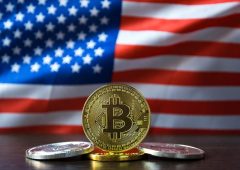US PCE Inflation Holds Steady at 2.5% in February, Core Index Surpasses Expectations
28.03.2025 18:00 1 min. read Alexander Stefanov
In February, the U.S. maintained its annual inflation rate at 2.5%, as reflected in the Personal Consumption Expenditures (PCE) Price Index, according to data released by the Bureau of Economic Analysis.
This figure matched both market expectations and January’s result.
The core PCE index, which excludes volatile food and energy prices, saw a 2.8% year-over-year increase, surpassing the forecast of 2.7% and outpacing the previous month’s 2.7%. On a month-to-month basis, the overall PCE index rose by 0.3%, while the core index grew by 0.4%.
Further details showed that personal income climbed by 0.8% monthly, while personal spending grew by 0.4%.
Market reactions to this data were swift, with the U.S. dollar gaining strength against major currencies. At the time of reporting, the USD Index had risen by 0.12%, reaching 140.40. Among the major currencies, the USD performed particularly well against the Japanese Yen.
This report came ahead of a broader market expectation that the Federal Reserve will keep interest rates steady in May, with a continued focus on monitoring inflationary trends. The core PCE is expected to rise by 0.3% month-over-month and 2.7% year-over-year for February, while overall inflation should remain at 2.5%.
-
1
Robert Kiyosaki Predicts When The Price of Silver Will Explode
28.06.2025 16:30 2 min. read -
2
Trump Targets Powell as Fed Holds Rates: Who Could Replace Him?
27.06.2025 9:00 2 min. read -
3
U.S. PCE Inflation Rises for First Time Since February, Fed Rate Cut Likely Delayed
27.06.2025 18:00 1 min. read -
4
Key U.S. Economic Events to Watch Next Week
06.07.2025 19:00 2 min. read -
5
Gold Beats U.S. Stock Market Over 25 Years, Even With Dividends Included
13.07.2025 15:00 1 min. read
Gold Beats U.S. Stock Market Over 25 Years, Even With Dividends Included
In a surprising long-term performance shift, gold has officially outpaced the U.S. stock market over the past 25 years—dividends included.
U.S. Announces Sweeping New Tariffs on 30+ Countries
The United States has rolled out a broad set of new import tariffs this week, targeting over 30 countries and economic blocs in a sharp escalation of its trade protection measures, according to list from WatcherGuru.
Key U.S. Economic Events to Watch Next Week
After a week of record-setting gains in U.S. markets, investors are shifting focus to a quieter yet crucial stretch of macroeconomic developments.
Robert Kiyosaki Predicts When The Price of Silver Will Explode
Robert Kiyosaki, author of Rich Dad Poor Dad, has issued a bold prediction on silver, calling it the “best asymmetric buy” currently available.
-
1
Robert Kiyosaki Predicts When The Price of Silver Will Explode
28.06.2025 16:30 2 min. read -
2
Trump Targets Powell as Fed Holds Rates: Who Could Replace Him?
27.06.2025 9:00 2 min. read -
3
U.S. PCE Inflation Rises for First Time Since February, Fed Rate Cut Likely Delayed
27.06.2025 18:00 1 min. read -
4
Key U.S. Economic Events to Watch Next Week
06.07.2025 19:00 2 min. read -
5
Gold Beats U.S. Stock Market Over 25 Years, Even With Dividends Included
13.07.2025 15:00 1 min. read


